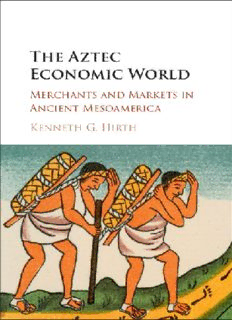
The Aztec Economic World: Merchants and Markets in Ancient Mesoamerica PDF
Preview The Aztec Economic World: Merchants and Markets in Ancient Mesoamerica
The Aztec Economic World Thisstudyexplorestheorganization,scale,complexity,andintegration ofAzteccommerceacrossMesoamericaatSpanishcontact.Theaimsof thebookarethreefold.Thefirstistoconstructanin-depthunderstand- ing of the economic organization of precolumbian Aztec society and how it developed in the way that it did. The second is to explore the livelihoods of the individuals who bought, sold, and moved goods acrossaculturallandscapethatlackedbothnavigableriversandanimal transport. Finally, this study models Aztec economy in a way that facilitates its comparison to other ancient and premodern societies around the world. What makes the Aztec economy unique is that it developed one of the most sophisticated market economies in the ancientworldinasocietywithoneoftheworsetransportationsystems. Thisisthefirstbooktoprovideanupdatedandcomprehensiveviewof theAztececonomyinthirtyyears. kenneth g. hirth is Professor of Anthropology at Penn State Uni- versity. His research focuses on the origin and development of ranked andstate-levelsocietiesintheNewWorld.Heisespeciallyinterestedin politicaleconomyandhowformsofresourcecontrolleadtothedevel- opmentofstructuralinequalitieswithinsociety. The Aztec Economic World Merchants and Markets in Ancient Mesoamerica KENNETH G. HIRTH DepartmentofAnthropology PennStateUniversity 32AvenueoftheAmericas,NewYork,ny10013–2473,USA CambridgeUniversityPressispartoftheUniversityofCambridge. ItfurtherstheUniversity’smissionbydisseminatingknowledgeinthepursuitof education,learningandresearchatthehighestinternationallevelsofexcellence. www.cambridge.org Informationonthistitle:www.cambridge.org/9781107142770 ©KennethG.Hirth2016 Thispublicationisincopyright.Subjecttostatutoryexception andtotheprovisionsofrelevantcollectivelicensingagreements, noreproductionofanypartmaytakeplacewithoutthewritten permissionofCambridgeUniversityPress. Firstpublished2016 PrintedintheUnitedStatesofAmericabySheridanBooks,Inc. AcataloguerecordforthispublicationisavailablefromtheBritishLibrary LibraryofCongressCataloginginPublicationData Hirth,Kenn. TheAztececonomicworld:merchantsandmarketsinancientMesoamerica/byKenneth G.Hirth,DepartmentofAnthropology,PennStateUniversity. pagescm Includesbibliographicalreferencesandindex. isbn978-1-107-14277-0(Hardback) 1.Aztecs–Economicconditions.2.Aztecs–Commerce.3.Merchants–Mexico–History–To 1500.4.IndiansofMexico–Economicconditions.5.IndiansofMexico–Commerce– History–To1500.I.Title.II.Title:MerchantsandmarketsinancientMesoamerica. f1219.76.e36h572016 972–dc23 2015034786 isbn978-1-107-14277-0Hardback CambridgeUniversityPresshasnoresponsibilityforthepersistenceoraccuracy ofURLsforexternalorthird-partyinternetwebsitesreferredtointhispublication, anddoesnotguaranteethatanycontentonsuchwebsitesis,orwillremain, accurateorappropriate. Contents List of figures page vii List of tables xi Preface xiii Abbreviations xvii 1 Introduction to theAztec economic world 1 2 The structure of Mesoamerican economy 19 3 The Mesoamerican marketplace 59 4 Merchants,profit, and the precolumbian world 90 5 Often invisible: domesticentrepreneursin Mesoamerican commerce 102 6 The professional retail merchants 151 7 Merchant communities and pochteca vanguard merchants 188 8 The toolsof thetrade and the mechanics of commerce 237 9 Conclusions 270 Notes 295 Glossary ofNahuatl and early colonialSpanish terms 329 Bibliography 333 Index 371 v Figures 1.1 Western Mesoamerica:Major communities and altepeme centers mentioned in the text (Illustration by Tara Mazurczyk) page 4 1.2 The Aztecworld and empire (Illustration by Tara Mazurczyk) 5 1.3 Major prehispanic and colonialcommunities inMesoamerica (Illustration by TaraMazurczyk) 5 1.4 Tierra Fria and Tierra Helada environment ofthe Iztaccihuatl volcanoin Central Mexico (Photograph by Gerardo Gutierrez) 6 1.5 Climatic zones inMesoamerica. Tierra Caliente 0–1,000 m msl; Tierra Templada 1,000–2,000 m msl; Tierra Fria and Tierra Helada, above 2,000 m msl (Illustration by the author) 7 1.6 Mangrove swamp along the Pacific coast of Xoconochco (Photograph by Gerardo Gutierrez) 7 1.7 Thorn Forest in theTehuacanValley, Puebla, Mexico (Photograph by Gerardo Gutierrez) 8 1.8 Areas ofthe Mexican highlands within 30 km of another ecological interface (Illustration by the author) 9 1.9 Tlameme porters (Illustration by KarinDennisonand MaryVinciguerraredrawn from Sahagún 2008:1317) 11 1.10 Canoe transportation in the Aztec world (Illustration by Karin Dennison and Mary Vinciguerraredrawn from Berdan and Anawalt 1992:3:135) 12 vii viii List of figures 2.1 Amodel of thedomestic and institutional economy showing the interaction of householdsthrough informal and formal institutions (Illustration by the author) 22 2.2 Example of coatequitllabor illustrating the digging stick used in corvee labor. (Illustration by Karin Dennisonand Mary Vinciguerra redrawn from Berdan andAnawalt 1992:3:147) 39 2.3 Thearray of high-valueitemsmade for warriors inone of the totocalli workshops.Notice the footprintsemerging from the inverted house inthe lowerright hand corner indicating these items arecoming from thebuilding the workshopwas housed (from Sahagún 1905–1907) 45 2.4 Feather worker,like thosewho worked feathers inthe totocalli (from Sahagún 1905–1907) 46 2.5 Woman weavingon a backstrap loom (from Sahagún 1905–1907) 47 2.6 Inter-regionalspheres ofcotton trade across Central Mexico (Illustration by the author) 51 3.1 PrehispanicmarketplaceinMichoacan(IllustrationbyKarin DennisonredrawnfromWilliams1997andCraineand Reindorp1970) 63 3.2 Goods soldin the marketplace. Note the glyphfor the marketplace in the lower left handcornerof the illustration (Modified by the author from Sahagún 2008:1336) 67 3.3 Themarketplace represented asa circle. Notice the circular market shrine in thecenterof the marketplace. (Illustration by Karin Dennison redrawn from Durán 1971: plate 29) 74 3.4 Hypothetical decline ininventory of an itinerant merchant over afivedayperiodif a20%market tax was paid each day ata marketplace (Illustration by the author) 77 3.5 Marketplaces in the Basin ofMexicoand adjacent areas (Illustration by TaraMazurczyk) 84 3.6 Documented marketplaces in Mesoamerica in the early sixteenthcentury(Illustration by Tara Mazurczyk) 85 4.1 Merchants on the road (from Sahagún1905–1907) 97 5.1 Thefarmer producing and harvesting maize (Modified by the author from Sahagún 2008:1566) 115 5.2 Themaize seller (Modified by theauthor from Sahagún 2008:1604) 115 5.3 Thetamale seller (Modified by theauthorfrom Sahagún 2008:1610) 118 List of figures ix 5.4 Thechocolate-drink seller (Modified by the author from Sahagún 2008:1648) 119 5.5 Thelime seller (Modified by the author from Sahagún 2008:1648) 125 5.6 Apair of icpacactli fibersandals boughtin the Cuautla in themid-1970s.Sandals arefora child and aremade of maguey fiber (Photograph by KarinDennison) 134 5.7 Thecarpenter (Modified by the author from Sahagún 2008:1627) 136 5.8 Thegoldsmith(Modified by theauthorfrom Sahagún 2008:1458) 138 5.9 Theprostitute (Modified by theauthorfrom Sahagún 2008:1649) 142 5.10 Thegood solicitor (Modified by theauthorfrom Sahagún 2008:1554) 144 6.1 Thebean dealer (Modified by the author from Sahagún 2008:1605) 162 6.2 Thesalt dealer (Modified by the author from Sahagún 2008:1648) 163 6.3 Salt distribution networks across western Mesoamerica (Illustration by the author) 164 6.4 Thetobacco dealer (Modified by the author from Sahagún 2008:1649) 165 6.5 Themerchant peddler (Modified by the author from Sahagún 2008:1568) 173 7.1 Pochtecamerchantsandtheirgoods(fromSahagún 1905–1907) 190 7.2 Merchant communities inthe Basin of Mexico (Illustration by Deborah Nichols) 191 7.3 Thearchaeological site ofOtumba illustrating specialized craft production areas (Illustration by Deborah Nichols) 196 7.4 Merchantsin the Quetzalhuacan tributecadreof Santa Maria Acxotla. Thetwo obsidian merchant craftsmen arelocated at thetop left and bottom ofthe left column and are identified by theixcalotli instrument heldin the hand alongside the headglyph of thecraftsman. (Illustration redrawn from the Matrícula de Huexotzinco 627vby KarinDennison) 201 7.5 Craftsmen residing indifferent barrios at Santa Maria Axcotla: a)tobaccotubemaker, b) paper maker, c) resin collector, d)stone worker,e)ceramicist, f) doctor, g)fiscal, h) obsidian
Description: